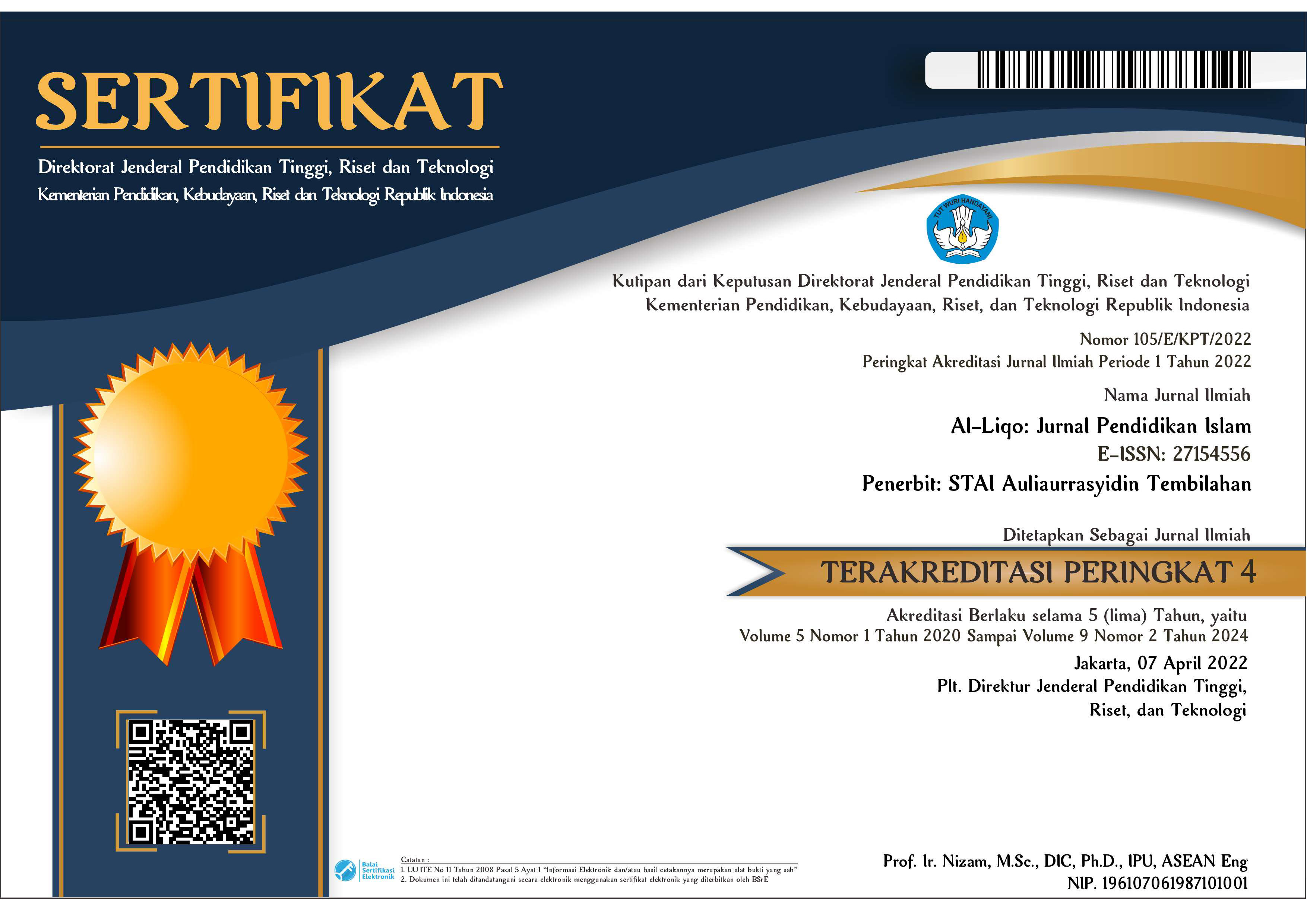Strategi Kepala Madrasah dalam Menanamkan Nilai Humanis Religius kepada Siswa Madrasah Aliyah
DOI:
https://doi.org/10.46963/alliqo.v9i1.1095Keywords:
Strategy, Values, Religious HumanistAbstract
The aim of the research is to explain the strategy related to the headmaster of the madrasa in instilling religious humanist values in Madrasah Aliyah Ibnul Qoyyim Yogyakarta students. The cultivation of religious humanist values is carried out to form students who have good morals and noble character. When morals and morals are instilled in students, it becomes an important first step towards a smarter future for Indonesia. This research uses field research with a descriptive approach. The results of the research strategy in an effort to instill religious humanist values at the Ibnul Qoyyim Yogyakarta Madrasah have been maximized, starting with giving an example by having joint prayers, attendance/fingerprints, and dress codes, then the habituation is carried out, namely starting from apples every week, activities garbage banks, congregational midday prayers, dhuha prayers, recitations of the Koran, Infaq, then the correction of supervision and the existence of punishments are able to create school areas that are able to create religious humanism values, because every policy made certainly does not escape from the principles of the Qur'an an and Hadith.
Downloads
References
Achmad, D. (2010). Revitalisasi Fungsi Pendidikan untuk Mewujudkan Pendidikan yang Humanisreligius. Universitas Negeri Yogyakarta.
Amirudin, N. (2019). Problematika Pembelajaran Pendidikan Agama Islam Di Era Digital. Prosiding Seminar Nasional Prodi Pai Ump, 181.
Ansori, R. A. M. (2016). Strategi Penanaman Nilai-Nilai Pendidikan Islam Pada Peserta Didik. Jurnal Pustaka, 8(1), 14–32.
Arief, A. (n.d.). Pendidikan humanistik: konsep, teori, dan aplikasi praksis dalam dunia pendidikan. Ar-Ruzz Media.
Arief, A. (2002). Pengantar Ilmu dan Metodologi Pendidikan Islam. Ciputat Press.
Bahri, S. (2015). Implementasi Pendidikan Karakter Dalam Mengatasi Krisis Moral Di Sekolah. Ta’allum, 3(1), 57–67.
Cholil, A. F. (2019). Pengaruh Globalisasi Dan Era Disrupsi Terhadap Pendidikan Dan Nilai-Nilai Keislaman. Sukma: Jurnal Pendidikan, 3(1), 117–136.
Daradjat, Z. (1996). Ilmu Jiwa Agama. Bulan Bintang.
Djamar dan Zain. (2006). Strategi Belajar Mengajar. Rieneka Cipta.
Haryanto, A.-F. (2011). Desain Pembelajaran yang Demokratis dan Humanis. Ar-Ruzz Media.
Herti, Y. D. (2019). Nilai-Nilai Pendidikan Humanis dalam Surat An-Nisa Ayat 63. Jurnal Kependidikan, 7(2), 158–161.
Hidayatullah, F. (2010). Pendidikan Karakter: Membangun Peradaban Bangsa. Yuma Pressindo.
Mustaqim, A. (2001). Akhlak Tasawuf Jalan Menuju Revolusi Spiritual. Kreasi Wacana.
Priatmoko, S. (2018). Memperkuat Eksistensi Pendidikan Islam Di Era 4.0. Ta’lim: Jurnal Studi Pendidikan Islam, 1(2), 2.
Sumarno dan Septina Alrianingrum. (2020). Pendidikan Nilai dan Karakter. UNESA University Press.
Suprapmanto, J. . dk. (2015). Upaya Mengembalikan Jati Diri Siswa dengan Menanamkan Nilai Pendidikan Karakter. SENAPADMA, 1(1), 1–10.
Suwardana, H. (2018). Revolusi Industri 4.0 Berbasis Revolusi Mental. Jati Unik, 1(2), 109–118.
Syafri, U. A. (2014). Pendidikan Karater Berbasis Al-Qur’an. Raja Grafindo Persada.
Tim Dosen Fakultas Tarbiyah IAIN Wali Songo Semaran. (1999). Metodologi Pengajaran Agama. Pustaka Pelajar.
Downloads
Published
Issue
Section
License
Copyright (c) 2024 Lia Dwi Utami, Iis Siti Khoiriyah

This work is licensed under a Creative Commons Attribution-ShareAlike 4.0 International License.
Authors who publish with this journal agree to the following terms:
1. Copyright on any article is retained by the author(s).
2. The author grants the journal, right of first publication with the work simultaneously licensed under a Creative Commons Attribution shareAlike 4.0 International License that allows others to share the work with an acknowledgment of the work’s authorship and initial publication in this journal.
3. Authors are able to enter into separate, additional contractual arrangements for the non-exclusive distribution of the journal’s published version of the work (e.g., post it to an institutional repository or publish it in a book), with an acknowledgment of its initial publication in this journal.
4. Authors are permitted and encouraged to post their work online (e.g., in institutional repositories or on their website) prior to and during the submission process, as it can lead to productive exchanges, as well as earlier and greater citation of published work.
5. The article and any associated published material is distributed under the Creative Commons Attribution-ShareAlike 4.0 International License







2.png)



